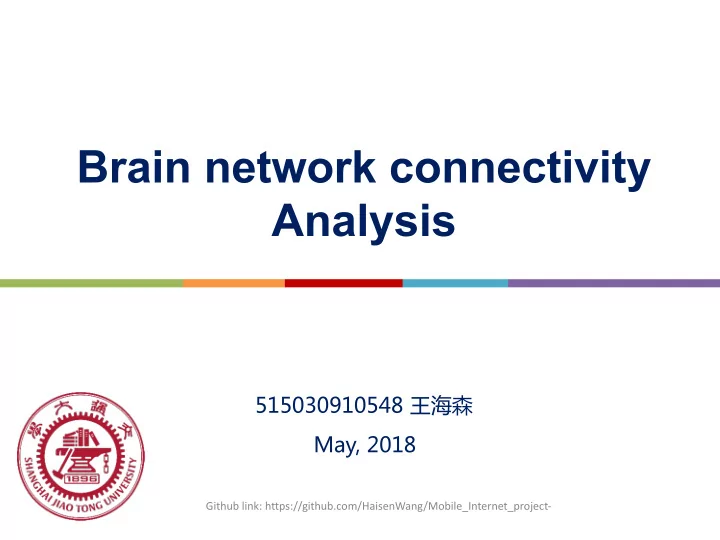

Brain network connectivity Analysis ��� � �� ������� ������ �� Github link: https://github.com/HaisenWang/Mobile_Internet_project-
� ����20��3�2��� �� ��2���1 Outline �� ��13�21 �� �3230��4�0� �� ����0����
01 ������������
Brain Network q Functional system q A hierarchically modularized set of canonical networks is now widely accepted as an organizational principle of the brain q By identifying patterns of synchronous brain activity, functional magnetic resonance neuroimaging (fMRI) techniques have partitioned the human brain into large-scale networks Github link: https://github.com/HaisenWang/Mobile_Inter net_project-
fMRI q Functional magnetic resonance imaging or functional MRI (fMRI) measures brain activity by detecting changes associated with blood flow. This technique relies on the fact that cerebral blood flow and neuronal activation are coupled. When an area of the brain is in use, blood flow to that region also increases. q The most primitive fMRI data is 4-dimensional, contains measurements of space and one-dimensional time. Github link: https://github.com/HaisenWang/Mobile_Inter net_project-
ICA q Spatial Independent Component Analysis (ICA) is an increasingly used data-driven method to analyze functional Magnetic Resonance Imaging (fMRI) data. A hierarchical model for patterns q in multi-subject fMRI datasets, akin to mixed-effect group models used in linear-model-based analysis was proposed in 2010. Here we use the ‘CanICA’ approach which implements a multivariate random effects model across subjects to extract brain networks in an data-driven way. Github link: https://github.com/HaisenWang/Mobile_Inter net_project-
Functional Connectivity q Functional connectivity is the connectivity between brain regions that share functional properties. q Functional connectivity has been suggested to be an expression of the network behavior underlying high level cognitive function partially. Github link: https://github.com/HaisenWang/Mobile_Inter net_project-
02 �������
ICA p Step one: Data preparation: retrieving example data Ø We will use sample data from the ADHD 200 resting-state dataset has been preprocessed using CPAC . Github link: https://github.com/HaisenWang/Mobile_Inter net_project-
ICA p Step two: Applying CanICA Ø CanICA is a ready-to-use object that can be applied to multi-subject Nifti data, for instance presented as filenames, and will perform a multi-subject ICA decomposition following the CanICA model. As with every object in nilearn, we give its parameters at construction, and then fit it on the data. Github link: https://github.com/HaisenWang/Mobile_Inter net_project-
ICA p Step three: Visualizing the results We can show both of the whole component and the map for different ICA Ø components. Github link: https://github.com/HaisenWang/Mobile_Inter net_project-
Functional Connectivity p Step 1: Mask Ø We know that the most primitive fMRI data is 4-dimensional, contains measurements of space and one-dimensional time. So our first step is to transform the four dimensional data to a two- dimensional matrix. It is called Mask. And it is as follows. Github link: https://github.com/HaisenWang/Mobile_Inter net_project-
Functional Connectivity p Step 2: Timeseries Ø After masking, the features are still too much. Next we need to do is extract the time series. Due to too many features, we will use resampling to map these features to our existing validated maps. Here we use the Altas map. p Step 3:Functional connectomes: Ø After masking, the features are still too much. Next we need to do is extract the time series. Due to too many features, we will use resampling to map these features to our existing validated maps. Here we use the Altas map. Github link: https://github.com/HaisenWang/Mobile_Inter net_project-
03 �������
ICA q All the components Github link: https://github.com/HaisenWang/Mobile_Inter net_project-
ICA q Maps for different ICA components: Github link: https://github.com/HaisenWang/Mobile_Inter net_project-
Functional Connectivity q correlation matrix Github link: https://github.com/HaisenWang/Mobile_Inter net_project-
Functional Connectivity q corresponding graph of the brain network. Github link: https://github.com/HaisenWang/Mobile_Inter net_project-
04 ����� �����
Future work p Dynamic Functional connectivity p Multistable model Github link: https://github.com/HaisenWang/Mobile_Inter net_project-
05 ���������
Reference • Varoquaux G, Craddock R C. Learning and comparing functional connectomes across subjects[J]. NeuroImage, 2013, 80: 405-415. • Varoquaux G, Sadaghiani S, Pinel P, et al. A group model for stable multi- subject ICA on fMRI datasets[J]. Neuroimage, 2010, 51(1): 288-299. • Ciric R, Nomi J S, Uddin L Q, et al. Contextual connectivity: A framework for understanding the intrinsic dynamic architecture of large-scale functional brain networks[J]. Scientific reports, 2017, 7(1): 6537. • Varoquaux G, Craddock R C. Learning and comparing functional connectomes across subjects[J]. NeuroImage, 2013, 80: 405-415. • http://nilearn.github.io/ Github link: https://github.com/HaisenWang/Mobile_Inter net_project-
Thank you ! Github link: https://github.com/HaisenWang/Mobile_Inter net_project-
Recommend
More recommend